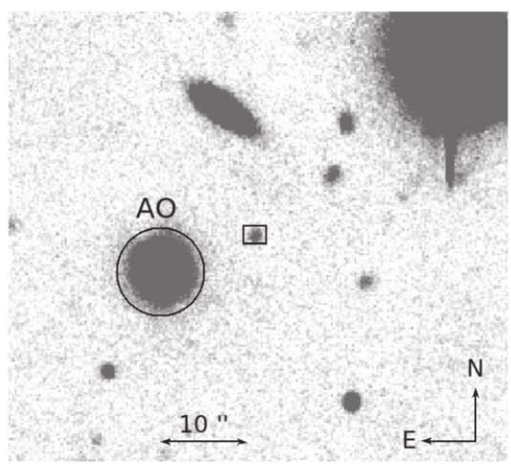An Unexpected Gamma Ray Burst
Classifying gamma-ray bursts -rapid phenomena amongst the most energetic in the Universe- on the basis of their duration is the most commonly adopted approach by the astronomical community. However, recent observations have shown that this classification is not sufficient to uniquely reveal the nature of the progenitor that originated the burst. An example is GRB 200826A, a very peculiar gamma-ray burst: whereas its duration, about half a second, would classify it as a short burst, almost every other characteristic of the event was consistent with long bursts.
A new study, led by Andrea Rossi, a researcher at the Italian National Institute of Astrophysics (INAF), has shown that the gamma-ray burst GRB 200826A, first observed in 2020, is associated with a supernova, i.e. the explosion of a massive star, unlike other short gamma-ray bursts. The results, based on a one-year campaign involving two INAF facilities, the Large Binocular Telescope (LBT) located on Mount Graham in Arizona (USA) and the Telescopio Nazionale Galileo, as well as at the Maidanak Astronomical Observatory in Uzbekistan, have been published in The Astrophysical Journal.
Gamma-ray bursts (GRBs) are explosions that release jets of matter with speeds close to the speed of light. Astronomers observe them as extremely bright flashes at gamma-ray frequencies, so intense that they overwhelm any other high-energy source. GRBs are divided into long and short classes on the basis of their duration. In particular, short gamma-ray bursts last from a few tens of milliseconds up to 2 seconds, and are usually associated with the merger of two neutron stars or the merger of a neutron star with a black hole. Long bursts last longer than 2 seconds and are associated with the explosion of a star that has reached the end of its life and has a mass greater than 5-10 times that of the Sun.
For the first time, adaptive optics were used to observe a supernova associated with a gamma-ray burst: thanks to these observations, astronomers have shown that not just long gamma-ray bursts but also short GRBs can be the result of the collapse of a massive star and therefore the duration of the gamma-ray burst is not an efficient discriminator for understanding the origin of GRBs. When combined with one of the 8 meter mirrors on the Large Binocular Telescope, adaptive optics allowed to clearly measure the infrared light and, by repeating the observation after 4 months, it was posible to watch the supernova fade and pinpoint exactly where in the very distant galaxy the event occurred.
Due to the expansion of the Universe, all galaxies (and objects within them) appear to be receding from us. The result is that light emitted at a certain wavelength will appear to be redshifted, or shifted towards longer wavelengths, when it is observed on Earth. In the case of this gamma-ray burst, the radiation traveled for about 7 billion years before reaching us: this means that emission in optical wavelengths corresponds to an observation in the infrared. Thanks to the LBT observations with adaptive optics at infrared wavelengths, it is possible to observe faint and distant sources and then compare them with brighter, closer, and better known ones observed at optical wavelengths. The TNG monitoring allowed the reconstruction of the photometric light curve and to fix a bump about 75 days after the burst.
Supernovae associated with gamma-ray bursts are Type-Ic supernovae, originating from the collapse of the core of very massive stars that have lost much of their upper atmosphere. The fact that these supernovae have been associated with short gamma-ray bursts means that perhaps astronomers need to rethink some characteristics of these events. GRB 200826A is located in a very small galaxy that is forming new stars very rapidly.
Decades of observations of other galaxies show that when stars form very rapidly, they form many massive stars (at least 8-10x more massive than our Sun) which are short lived (tens of millions of years) and then explode in a supernova. And -at least in this case- also emitting the short gamma-ray burst observed. The results of this study have shown the new potential of adaptive optics and, at the same time, pose new questions: How can a gamma-ray burst associated with a supernova be so short in time? Astronomers will try to figure it out in the near future...

1' x 1' FOV finding chart derived from the TNG r' -band imaging obtained on 2020 September 27 UT. The star used for AO observations with LBT. The rectangular region is centered on the location of the afterglow.
For more information:
The article "The peculiar short-duration GRB 200826A and its supernova" by
A. Rossi, B. Rothberg, E. Palazzi, D. A. Kann, P. D'Avanzo, L. Amati,
S. Klose, A. Perego, E. Pian, C. Guidorzi, A. S. Pozanenko, S. Savaglio,
G. Stratta, G. Agapito, S. Covino, F. Cusano, V. D'Elia, M. De Pasquale,
M. Della Valle, O. Kuhn, L. Izzo, E. Loffredo, N. Masetti, A. Melandri,
P. Y. Minaev, A. Nicuesa Guelbenzu, D. Paris, S. Paiano, C. Plantet,
F. Rossi, R. Salvaterra, S. Schulze, C. Veillet and A. A. Volnova is
published online in The Astrophysical Journal.

